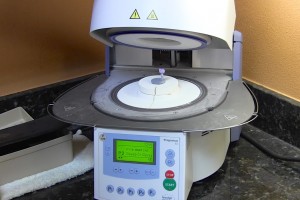Dental Crowns are probably one of the most common types of dental restorations. Most people are familiar with the term ‘Crown’, but often do not know exactly what a crown, and the procedure to get a dental crown fitted entails. Before I discuss the dental crown procedure, I think it is important that Cosmetic Dentistry Advisor provide some information on what a dental crown is, when it is used and the types of crowns available.
What are Dental Crowns
A normal healthy tooth consists of roots and a clinical crown, which is the part of the tooth that is visible in the mouth. When this part of the tooth is entirely covered by a ‘cap’, it is called a dental crown. The crown helps to strengthen the tooth and restore function. It can also improve the shape, appearance and alignment of the tooth. A crown can also be supported by an implant if the original tooth and roots have been removed.

Dental Crown
When are Dental Crowns required?
Severely Decayed Tooth
When a tooth has decay to the extent that the remaining tooth structure cannot support such a large filling, a crown is required. If a tooth already has a very large filling, it may also be advisable to consider a crown, in order to prevent it from fracturing.

Decayed Teeth
Broken Teeth
If a relatively large part of a tooth has fractured, especially if it involves one or more cusps, it is advisable to crown the tooth as such a large filling is very likely to fracture.
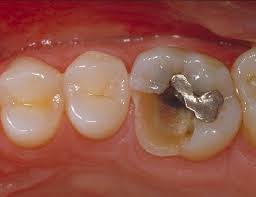
Fractured Tooth
Cracked Tooth Syndrome
A tooth can have a fracture inside which may/may not be visible, but causes pain when biting on the tooth. Often, a crown will help to hold the tooth together and spread the biting forces evenly, which will prevent it from further damage and eliminate the pain, although a root canal treatment may be required first.
Following Root Canal Treatment
A tooth can be predisposed to fracturing after root canal treatment and it is therefore common to place a crown on the tooth, in order to ensure a strong, durable outcome.
Excessive Wear
People who tend to grind on their teeth may find that their teeth become shorter over time. This may also be caused, or aggravated by acid erosion from food/drinks such as cola and also acid reflux. In order to restore the teeth to a more reasonable size, and the bite to what it should be, these teeth should be crowned.

Excessive wear on teeth
Cosmetic Treatment
Misshapen, severely discolored and misaligned teeth can be crowned in order to achieve the desired aesthetic result. The crowns can be used in combination with dental veneers, bridges and composite fillings, as part of a comprehensive cosmetic treatment.
Implants and Bridges
Crowns are also used on dental implants and to support dental bridges.
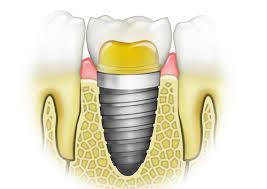
Implant Crown
Problems with Dental Crowns
- Secondary decay: People often do not realize that teeth with crowns can still get decay. As the natural roots are not protected by the crown, they can get decayed. If this goes undetected and untreated, it can even cause tooth loss. It is therefore extremely important to maintain immaculate oral hygiene, giving special attention to cleaning next to the gum line and between the teeth. A mouthwash can also be of great help to avoid this problem.
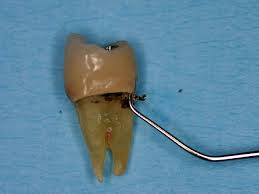
Decay on a Crowned Tooth
- Loose Crowns: Unfortunately crowns can loosen and fall off. This may be due to a lack of retention (especially if the stump of the original tooth is very small), improper fit or cement loosening over time. Very sticky toffees can stick to the crown and pull it out; it is therefore advisable to refrain from eating very sticky sweats if you have dental crowns.
- Crowns can chip: Porcelain and resin crowns can chip. Fortunately this doesn’t happen often but the crown may need replacement if it does happen. Be careful not to chew very hard things and do not use your crowns to open bottle caps etc. as this may cause the porcelain to fracture.
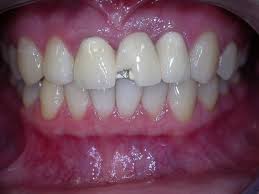
Fractured crown
- Sensitivity: Quite a bit of the original tooth needs to be removed when preparing it for a crown. This can cause a tooth to be sensitive after the preparation appointment or even after placement of the crown. If the tooth is extremely sensitive or the sensitivity doesn’t subside, you should see your dentists as the biting forces on the crown may be too high or there may be another problem.
- Dark line next to the gum: Depending on the type of crown, some of the metal may show next to the gum line. Some people may find this cosmetically unacceptable. The gums may also recede over time, leaving an unsightly space between the crown and the gum, where the tooth/root showing may not match the crown.

- Allergy: Although rare, some patients may get an allergic reaction to the materials used to make the crown. Patients with a known metal-allergy should certainly bring it to their dentist’s attention as a metal-free crown will be a better option in these circumstances.
Dental Crown Procedure
- Examination, x-rays and treatment plan: Before your dentist can start preparing the tooth for a crown, it is important do a thorough examination, including x-rays, in order to determine if a crown is the best treatment option for the tooth. If there is deep decay, fractures or signs of infection, the dentist may decide to do a root canal treatment first. As there are many different types of crowns, the dentist will probably discuss the different options and cost with the patient before finalizing the treatment plan.
- Remove decay and old fillings: All decayed tooth structure and bits of old filling material should be removed. If a root canal treatment has been done, some of the filling material inside one or more of the root canals will be removed, in order to create space for a post (which can be fitted inside the root).
- Shaping the tooth: If the tooth is still vital, the dentist may inject local anesthetic first. Some of the tooth will be filed down, in order to create space for the crown. The dentist may fit a post inside a prepared root canal, or simply leave it open, so the dental laboratory can cast a post to fit later. It may be necessary to use some filling material in order to get the desired shape for a crown.

Preparing the Tooth
- Impressions: An impression of the prepared tooth, as well as the opposing teeth will be taken. The dentist will probably also do a bite registration where he/she will ask the patient to bite on wax or other material. This will help the laboratory to see how the teeth fit together. The crown’s shade will also be determined by picking a color (shade) which matches the other teeth.

Impression
- Temporary crown: A temporary crown will be made and fitted with temporary cement. The temporary crown helps to protect the prepared tooth surface, maintain the space for the crown and prevent the gum from growing over the prepared tooth surface. It also covers the tooth, as a vital tooth will be very sensitive if left uncovered.
- Dental Laboratory: The dental laboratory will receive the impressions and cast models from it. They will then manufacture the crown as instructed by the dentist. It usually takes about two weeks to manufacture a crown.

Dental Laboratory
- Fitting the crown: During the second appointment, the temporary crown will be removed and the tooth cleaned. The dentist will check to see if the crown fits correctly and looks acceptable. It may be necessary to adjust the crown a bit. Very strong dental cement will then be used to fit the crown in place.
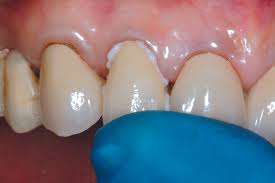
Cementing a Crown
Dental Crown Procedure for same-day, in-office crown.
The tooth will need preparation, similar to that of a lab-made crown. A scanning device will then be used to take digital pictures of the tooth and a 3D model of the tooth will be created on a computer. The digital crown design will then be sent to a machine that shapes and carves a ceramic block into the desired shape. This is called computer-aided manufacturing (CAD/CAM). Within about 15 minutes the crown will be ready and can be cemented onto the prepared tooth.
Types of Dental Crowns
- Metal: Metal crowns are very durable as they usually do not chip or break, even when there are very high forces on them. These crowns are great for people who tend to grind on their teeth, as long as it is not going to be visible when someone speaks or smile. As the metal is strong, even when it is very thin, less tooth structure needs to be removed when preparing the tooth, compared with other types of crowns. They can use gold alloy or other alloys such as palladium and also base-metal alloy like chromium or nickel.
- Resin crowns: All resin crowns are not as strong as other crowns but are quick to make and cost less than other types of crowns. They are often used as a temporary solution, until more durable crowns can be placed.
- All-porcelain or ceramic crowns: These crowns usually look great and can be used on a tooth which doesn’t need to withstand very high forces. Unfortunately they are not as strong as metal, zirconia or porcelain-fused-to-metal crowns.
- Zirconia crowns: They can be constructed in-office or at a dental lab. Zirconia crowns usually looks good and are strong.
- Porcelain-fused to metal: These crowns are a very popular choice as they are strong and look good.
- Prefabricated crowns: Prefabricated stainless steel crowns are often used on badly broken or decayed primary (children’s) teeth. They help to protect the tooth and maintain space for the permanent tooth. No impressions or lab work is required. Prefabricated crowns are also used as temporary crowns on permanent teeth.

Types of Crowns

